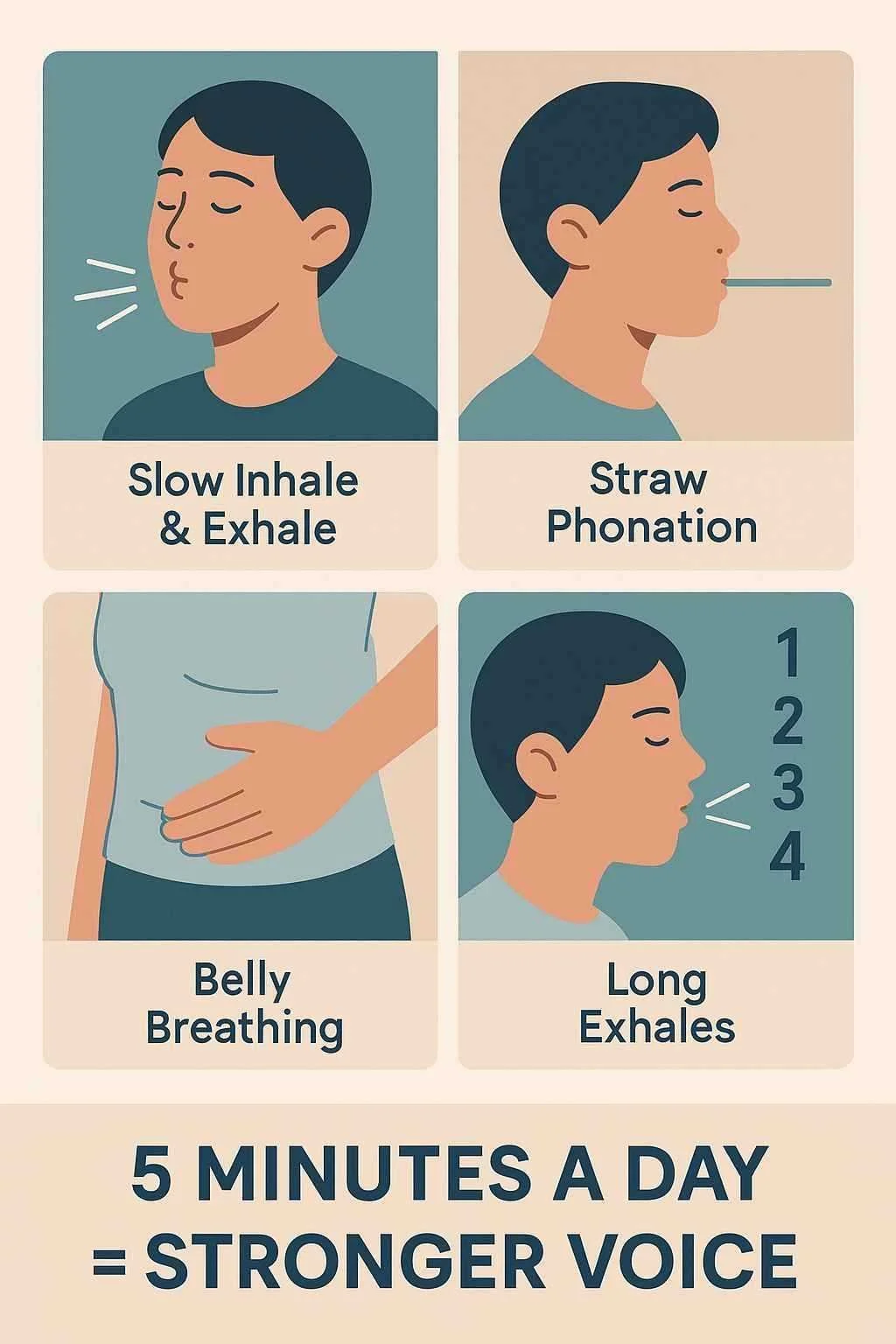How to Use Breath Control While Singing for a Powerful Voice
Breath control is the foundation of a strong singing voice. It helps with long phrases, high notes, and overall vocal health.
The good news is that controlling your breathing is learnable. With simple breathing exercises and good breath support, you can train your body to use air more effectively. This guide is for singers, families, and anyone who wants improved breathing and a healthier voice.
Key Takeaways:
What Breath Control Does: It is the ability to manage airflow while singing, which affects tone, pitch, and volume.
What Breath Control Involves: Breath support uses abdominal muscles and intercostal muscles to control air release and power the voice.
Breathing Technique: Belly and diaphragmatic breathing improve airflow, reduce tension, and support a stronger, steadier sound.
Vocal Health Habits: Good posture and hydration improve breath flow and help prevent strain on the vocal folds.
What Is Breath Control in Singing?
Breathing Exercises for Singers
Practicing Proper Breathing Techniques in Real Songs
Healthy Singing Habits Start with the Breath
Overcoming Vocal Strain Through Breath Management
When to Ask for Help For Better Breath Control
Frequently Asked Questions About Controlling Your Breath for Singing
What Is Breath Control in Singing?
Breath control is the ability to manage how much air you take in and how slowly you release it while singing. It is a core part of vocal technique and directly influences tone, pitch, volume, and overall vocal health.
With better control, the singing voice becomes fuller, steadier, and more expressive. Singers gain the ability to sing long phrases, stay in tune, and reach high notes with more confidence and less strain. Many singers who lack breath control run out of air mid-phrase or sound shaky and weak. These are signs that the breathing mechanism is not supporting the voice effectively.
Effective breath control depends on engaging the right muscle groups. This includes the diaphragm, abdominal muscles, intercostal muscles, and the lower stomach. When singers rely too much on the upper body or use shallow breathing, they often place unnecessary tension on the throat muscles and vocal cords.
Developing strong breath support starts with breathing deeply and silently through the nose. Techniques like diaphragmatic breathing and belly breathing help fill the lungs fully and create a steady, controlled exhale. This allows the voice to remain powerful and flexible throughout a performance.
Breath control exercises improve awareness of how much air you are using and how to release it in a controlled manner. Practicing these exercises regularly helps singers maintain good posture, stay relaxed, and activate the breath low in the body. Over time, this leads to more control, better breath management, and a healthier, more resilient singing voice.
Vocal coaches often emphasize breath control as one of the most important skills in developing vocal potential. Whether you are singing in a choir, performing on stage, or training as an opera singer, learning to control your breath is essential for vocal power, stamina, and sound quality.
Breathing Exercises for Singers
Use these breathing exercises to warm up your voice and breathing:
1) Slow Inhale and Exhale
Breathe in deeply through your nose
Hold for 3–5 seconds
Exhale slowly through pursed lips
Focus on steady airflow and relaxed muscles
2) Straw Phonation
Hum gently through a narrow straw
Keep the airflow smooth and even
Helps reduce tension and strengthens vocal folds
3) Long Exhales
Take a deep breath and release it slowly while counting aloud or hissing
Aim to extend the exhale gradually
Builds stamina and teaches air control
4) Belly Breathing with Hand Placement
Place one hand on your chest and one on your belly
Inhale and make sure only your belly rises
Encourages diaphragmatic breathing and better breath support
How often to practice:
Spend 5–10 minutes on these exercises each day. Listen for signs of steady and silent breathing and a relaxed voice. Over time, you'll notice more control and less strain while singing.
Practicing Proper Breathing Techniques in Real Songs
Once you’ve built some control, the next step is applying it to songs. Start by looking at the lyrics and marking where to breathe. Choose natural pauses, like at the end of a phrase or before a long note.
Practicing nose breathing during these pauses can help reduce throat tension and promote efficient breath intake. Planning breath spots enables you to stay supported and avoid running out of air mid-line.
Slow down the song and sing it at half speed. This helps you notice where the breath feels tight or rushed. Slower practice reveals weak spots in your breath support that might not show up at full tempo.
Record yourself singing and listen back. Pay attention to places where the sound fades or the pitch wavers. These moments often point to breathing issues. With practice, you’ll learn how to adjust your breathing for a smoother, more powerful performance.
Healthy Singing Habits Start with the Breath
Good posture and hydration are key to healthy breath flow. Understanding how the human body works together, posture, muscles, and breath, is essential for healthy singing. Stand tall with your shoulders relaxed and your rib cage open. Drink water regularly to keep your vocal folds moist and flexible, which makes breathing and singing easier.
Common mistakes include shallow breathing, lifting the shoulders while inhaling, and holding the breath too tightly. These habits create tension and limit the air you can use. Over time, they can lead to strain and fatigue in the throat muscles.
Better breath habits support long-term vocal health. When you breathe efficiently, your voice works with less effort. This protects your vocal folds and helps you sing with more ease and confidence for years to come.
Vocal Health for Singers
Check out our blog discussing the importance of vocal health for singers for more information!
Overcoming Vocal Strain Through Breath Management
Vocal strain can hold singers back, but effective breath management is the key to overcoming it. By using proper breathing techniques, such as diaphragmatic breathing and deep breathing, you can reduce unnecessary tension in your throat muscles and vocal cords. This helps prevent shallow breathing, which often leads to fatigue and strain.
To avoid vocal strain, focus on breathing deeply and supporting your sound with your abdominal muscles rather than pushing from your throat. Practice exhaling in a controlled, steady way, and stay relaxed throughout your upper body. Breathing exercises that emphasize great breath support will help you maintain a healthy balance between airflow and muscle engagement, protecting your voice from overuse.
Regularly practicing these breathing techniques not only helps you stay relaxed but also builds the muscle memory needed for healthy singing. By making breath management a priority, you’ll reduce the risk of tension and vocal fatigue, allowing your voice to perform at its best, song after song.
When to Ask for Help For Better Breath Control
Some singers need extra support to build a steady breath. If you often feel breathless mid-phrase, struggle to hold notes, or feel tension in your throat or shoulders while singing, it may be time to ask for help. These signs can point to inefficient breathing patterns that need guided support.
Voice therapy, focused on controlling your breathing, teaches you how to use your breathing mechanism more effectively. A speech-language pathologist will show you how to engage your diaphragm, use good breathing exercises, and reduce unnecessary tension.
Improved breathing doesn’t just help with singing. It also boosts confidence in public speaking, helps with clear daily communication, and can even reduce anxiety by encouraging slower, deeper breaths.
Voice & Performance Coaching Quiz
Take our quiz to find out if voice & performance coaching is right for you.
Frequently Asked Questions About Controlling Your Breath for Singing
1. How can I control my breath while singing?
To control your breath, focus on diaphragmatic breathing. Breathe deeply into your belly, not your chest, and use your abdominal muscles to manage the air you release. Practice slow exhales and mark breathing spots in your music to stay steady through long phrases.
2. Do singers hold their breath while singing?
Singers do not hold their breath. Instead, they release air in a controlled, steady stream to power the sound. Holding your breath creates tension and interrupts vocal flow.
3. What is the 4-7-8 breathing technique for?
The 4-7-8 technique helps calm the nervous system. You inhale for 4 seconds, hold for 7, and exhale slowly for 8. While not a singing exercise, it can be helpful before performing to reduce anxiety and focus your breath.
4. How can I stop being so breathy when singing?
If you want to know how to stop being so breathy when singing, you can learn from a speech-language pathologist who is also a singing voice specialist.
5. Why are breath control exercises important for singing?
Breath control exercises build strength, endurance, and stability in your voice. They train you to manage how much air you use and help you sing with less strain. Strong control of breathing also protects your vocal health and improves your overall vocal technique.
How Connected Speech Pathology Can Help
At Connected Speech Pathology, our team includes licensed speech-language pathologists who are also trained vocalists. This unique combination of clinical expertise and performance experience allows us to support singers with both healthy vocal habits and effective breath control.
We focus on building strong, sustainable techniques through diaphragmatic breathing, targeted breathing exercises, and postural alignment tailored to each singer’s needs. Our sessions help you develop the muscle memory, body awareness, and breath support needed for a consistent, resonant sound.
We work with a wide range of singers, including teen vocalists in school choirs, adult hobbyists, and musical theater performers preparing for roles. Whether you're just beginning or returning to singing after vocal strain, we guide you through safe, effective techniques that build confidence and promote vocal health.
Getting started is simple. You can reach out to schedule an evaluation or refer someone who may be experiencing vocal fatigue or difficulty with breath support. All sessions are conducted virtually, making expert guidance available no matter where you are.
Summary
Strong control can change the way you sing and feel about your voice. With steady practice and the proper support, you can build confidence, power, and control in every note.
If you or someone you know is struggling with breath support or vocal fatigue, help is available, and it can make all the difference. Accept it as a key part of your musical journey, just as any aspiring opera singer would, and continue to grow and develop your skills.
About the Author
Allison Geller is a communication coach, speech-language pathologist, and founder of Connected Speech Pathology, an international online practice providing professional communication coaching and speech therapy for children, teens, and adults. With more than two decades of experience, she has worked in medical and educational settings, published research on aphasia, and leads a team of specialists helping clients improve skills in public speaking, vocal presence, accent clarity, articulation, language, fluency, and interpersonal communication.












